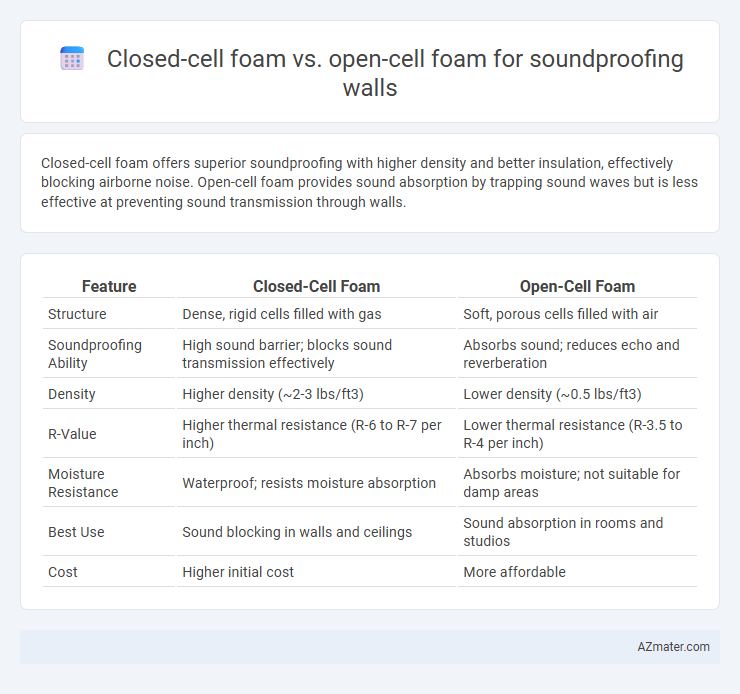Closed-cell foam offers superior soundproofing with higher density and better insulation, effectively blocking airborne noise. Open-cell foam provides sound absorption by trapping sound waves but is less effective at preventing sound transmission through walls.
Table of Comparison
| Feature | Closed-Cell Foam | Open-Cell Foam |
|---|---|---|
| Structure | Dense, rigid cells filled with gas | Soft, porous cells filled with air |
| Soundproofing Ability | High sound barrier; blocks sound transmission effectively | Absorbs sound; reduces echo and reverberation |
| Density | Higher density (~2-3 lbs/ft3) | Lower density (~0.5 lbs/ft3) |
| R-Value | Higher thermal resistance (R-6 to R-7 per inch) | Lower thermal resistance (R-3.5 to R-4 per inch) |
| Moisture Resistance | Waterproof; resists moisture absorption | Absorbs moisture; not suitable for damp areas |
| Best Use | Sound blocking in walls and ceilings | Sound absorption in rooms and studios |
| Cost | Higher initial cost | More affordable |
Introduction to Foam Soundproofing
Closed-cell foam offers superior soundproofing for walls due to its dense structure that effectively blocks airborne noise and prevents sound transmission. Open-cell foam, with its porous and flexible nature, excels at absorbing mid to high-frequency sound waves, reducing echo and reverberation within a room. Choosing between closed-cell and open-cell foam depends on specific soundproofing needs, such as insulation efficiency and desired noise reduction levels.
What is Closed-Cell Foam?
Closed-cell foam is a dense, rigid insulation material characterized by tightly packed cells filled with gas, providing superior soundproofing and moisture resistance for walls. Its high R-value per inch enhances thermal insulation while significantly reducing noise transmission compared to open-cell foam. Due to its structural rigidity, closed-cell foam acts as a strong barrier against airborne sound and external environmental conditions.
What is Open-Cell Foam?
Open-cell foam is a type of spray foam insulation characterized by its porous structure, allowing air to fill the tiny open cells within the material. This composition makes it more effective at absorbing sound waves, reducing noise transmission through walls by damping airborne sounds. While less dense than closed-cell foam, its soundproofing properties make it ideal for interior wall applications where noise reduction is a priority.
Key Differences Between Closed-Cell and Open-Cell Foam
Closed-cell foam has a dense, rigid structure that provides superior soundproofing by blocking airborne noise and reducing sound transmission through walls. Open-cell foam is softer and more porous, allowing it to absorb sound waves effectively and reduce echo within a room, but it is less effective at blocking noise from passing through walls. Key differences include closed-cell foam's higher density and moisture resistance, making it ideal for exterior walls, while open-cell foam's sound absorption properties suit interior applications where echo reduction is priority.
Soundproofing Performance: Closed-Cell vs Open-Cell Foam
Closed-cell foam provides superior soundproofing performance due to its dense, rigid structure, effectively blocking airborne noise and vibrations within walls. Open-cell foam, while offering excellent sound absorption by trapping sound waves within its porous matrix, is less effective at sound isolation because its softer composition allows more sound transmission. For optimal wall soundproofing, closed-cell foam minimizes sound leakage better than open-cell foam, making it the preferred choice in environments requiring maximum noise reduction.
Installation and Application Methods
Closed-cell foam offers superior soundproofing due to its dense structure, making it ideal for walls requiring high acoustic insulation, and is typically installed by spray application or rigid panels that seal gaps effectively. Open-cell foam, with its porous texture, absorbs sound waves well and is commonly applied via spray or batts, fitting irregular spaces but requiring thicker layers for optimal performance. Installation of closed-cell foam demands professional handling for proper curing and moisture resistance, whereas open-cell foam allows more DIY flexibility but may need additional vapor barriers in humid environments.
Cost Comparison: Which Foam is More Affordable?
Closed-cell foam typically costs more per square foot than open-cell foam due to its higher density and superior insulation properties. Open-cell foam offers a more budget-friendly option for soundproofing walls, making it suitable for larger areas or projects with cost constraints. While closed-cell foam provides better sound isolation, open-cell foam remains the more affordable choice for effective noise reduction.
Durability and Moisture Resistance
Closed-cell foam offers superior durability and moisture resistance compared to open-cell foam, making it ideal for soundproofing walls in areas prone to humidity or water exposure. Its dense structure prevents water absorption and maintains structural integrity over time, reducing the risk of mold and degradation. Open-cell foam, while effective for sound absorption, is less resistant to moisture and may deteriorate faster under damp conditions.
Best Use Cases for Each Foam Type
Closed-cell foam provides superior soundproofing for walls in environments requiring high-density noise barriers, such as recording studios and industrial settings, due to its rigid structure and excellent sound absorption properties. Open-cell foam excels in residential and office spaces by effectively reducing echo and airborne noise while offering enhanced breathability and flexibility for wall cavities. Selecting closed-cell foam is ideal for preventing sound transmission and moisture intrusion, whereas open-cell foam suits applications prioritizing sound diffusion and cost efficiency.
Choosing the Right Foam for Your Soundproofing Needs
Closed-cell foam offers superior soundproofing due to its dense, rigid structure that blocks airborne noise effectively, making it ideal for reducing loud sounds in walls. Open-cell foam, being softer and more porous, excels at absorbing mid to high-frequency sounds and controlling echoes within rooms but is less effective at blocking sound transmission. Selecting the right foam depends on your specific soundproofing goals: choose closed-cell foam for maximum noise isolation and open-cell foam for improved acoustic absorption inside spaces.

Infographic: Closed-cell foam vs Open-cell foam for Soundproofing wall
 azmater.com
azmater.com